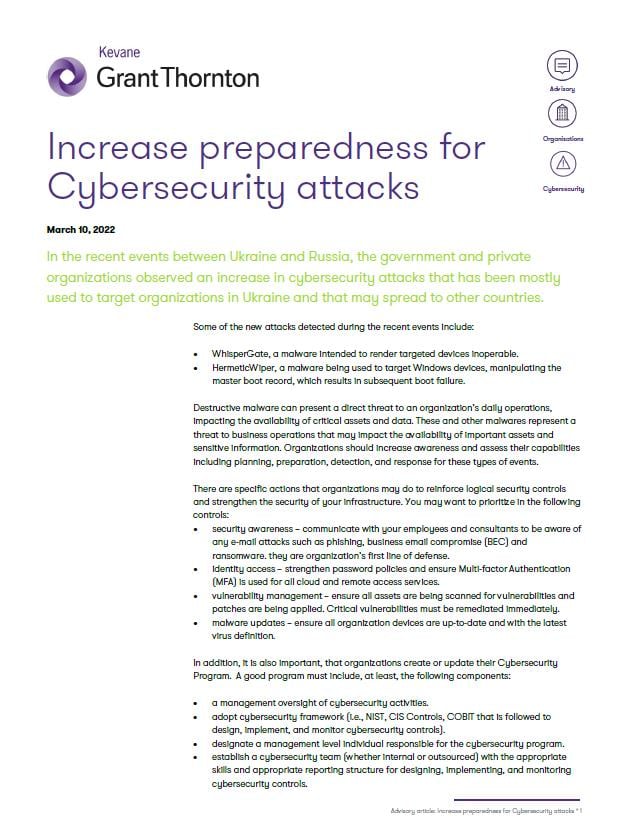-
Financial statements audits
Financial statement audits
-
Compliance audits
Compliance audits
-
Compilations and reviews
Compilations and audit
-
Agreed-upon procedures
Agreed-upon procedures
-
Corporate and business tax
Our trusted teams can prepare corporate tax files and ruling requests, support you with deferrals, accounting procedures and legitimate tax benefits.
-
International tax
Our teams have in-depth knowledge of the relationship between domestic and international tax laws.
-
Tax compliance
Business Tax
-
Individual taxes
Individual taxes
-
Estate and succession planning
Estate and succession planning
-
Global mobility services
Through our global organisation of member firms, we support both companies and individuals, providing insightful solutions to minimise the tax burden for both parties.
-
Sales and use tax and indirect taxes
SUT/ VAT & indirect taxes
-
Tax incentives program
Tax incentives program
-
Transfer Pricing Study
The laws surrounding transfer pricing are becoming ever more complex, as tax affairs of multinational companies are facing scrutiny from media, regulators and the public

-
Business consulting
Our business consulting services can help you improve your operational performance and productivity, adding value throughout your growth life cycle.
-
Forensic and investigative services
At Grant Thornton, we have a wealth of knowledge in forensic services and can support you with issues such as dispute resolution, fraud and insurance claims.
-
Fraud and investigations
The commercial landscape is changing fast. An ever more regulated environment means organizations today must adopt stringent governance and compliance processes. As business has become global, organizations need to adapt to deal with multi-jurisdictional investigations, litigation, and dispute resolution, address the threat of cyber-attack and at the same time protect the organization’s value.
-
Dispute resolutions
Our independent experts are experienced in advising on civil and criminal matters involving contract breaches, partnership disputes, auditor negligence, shareholder disputes and company valuations, disputes for corporates, the public sector and individuals. We act in all forms of dispute resolution, including litigation, arbitration, and mediation.
-
Business risk services
We can help you identify, understand and manage potential risks to safeguard your business and comply with regulatory requirements.
-
Internal audit
We work with our clients to assess their corporate level risk, identify areas of greatest risk and develop appropriate work plans and audit programs to mitigate these risks.
-
Service organization reports
As a service organization, you know how important it is to produce a report for your customers and their auditors that instills confidence and enhances their trust in your services. Grant Thornton Advisory professionals can help you determine which report(s) will satisfy your customers’ needs and provide relevant information to your customers and customers’ auditors that will be a business benefit to you.
-
Transactional advisory services
Transactions are significant events in the life of a business – a successful deal that can have a lasting impact on the future shape of the organizations involved. Because the stakes are high for both buyers and sellers, experience, determination and pragmatism are required to bring deals safely through to conclusion.
-
Mergers and acquisitions
Globalization and company growth ambitions are driving an increase in M&A activity worldwide as businesses look to establish a footprint in countries beyond their own. Even within their own regions, many businesses feel the pressure to acquire in order to establish a strategic presence in new markets, such as those being created by rapid technological innovation.
-
Valuations
We can support you throughout the transaction process – helping achieve the best possible outcome at the point of the transaction and in the longer term.
-
Recovery and reorganization
We provide a wide range of services to recovery and reorganisation professionals, companies and their stakeholders.
Some of the new attacks detected during the recent events include:
- WhisperGate, a malware intended to render targeted devices inoperable.
- HermeticWiper, a malware being used to target Windows devices, manipulating the master boot record, which results in subsequent boot failure.
Destructive malware can present a direct threat to an organization’s daily operations, impacting the availability of critical assets and data. These and other malwares represent a threat to business operations that may impact the availability of important assets and sensitive information. Organizations should increase awareness and assess their capabilities including planning, preparation, detection, and response for these types of events.
There are specific actions that organizations may do to reinforce logical security controls and strengthen the security of your infrastructure. You may want to prioritize in the following controls:
- security awareness – communicate with your employees and consultants to be aware of any e-mail attacks such as phishing, business email compromise (BEC) and ransomware. they are organization’s first line of defense.
- identity access – strengthen password policies and ensure Multi-factor Authentication (MFA) is used for all cloud and remote access services.
- vulnerability management – ensure all assets are being scanned for vulnerabilities and patches are being applied. Critical vulnerabilities must be remediated immediately.
- malware updates – ensure all organization devices are up-to-date and with the latest virus definition.
In addition, it is also important, that organizations create or update their Cybersecurity Program. A good program must include, at least, the following components:
- a management oversight of cybersecurity activities.
- adopt cybersecurity framework (i.e., NIST, CIS Controls, COBIT that is followed to design, implement, and monitor cybersecurity controls).
- designate a management level individual responsible for the cybersecurity program.
- establish a cybersecurity team (whether internal or outsourced) with the appropriate skills and appropriate reporting structure for designing, implementing, and monitoring cybersecurity controls.
- periodic assessment of the information technology (IT) environment for cybersecurity threats and vulnerabilities including, but not limited to, performing vulnerability and penetration testing.
It is also particularly important that upper management is in constant communication with the Cybersecurity team and that software vendors ensure active monitoring in order to make sure security controls are established and working as intended. In addition, the Incident Response Plan should be reviewed to ensure that new possible attack scenarios are identified, and response scenarios documented with possible response activities are discussed and approved.
The following is a list of resources that can help you increase your Cybersecurity controls and awareness:
- CyberSecurity & Infrastructure Security Agency (Homepage | CISA)
- National Institute of Standards and Technology (NIST) – Cybersecurity
- Center for Internet Security (CIS) – CIS Critical Security Controls v8
- National Institute of Standards and Technology (NIST) – Computer Security Incident Handling Guide
Resource:
Destructive Malware Targeting Organizations in Ukraine | CISA


